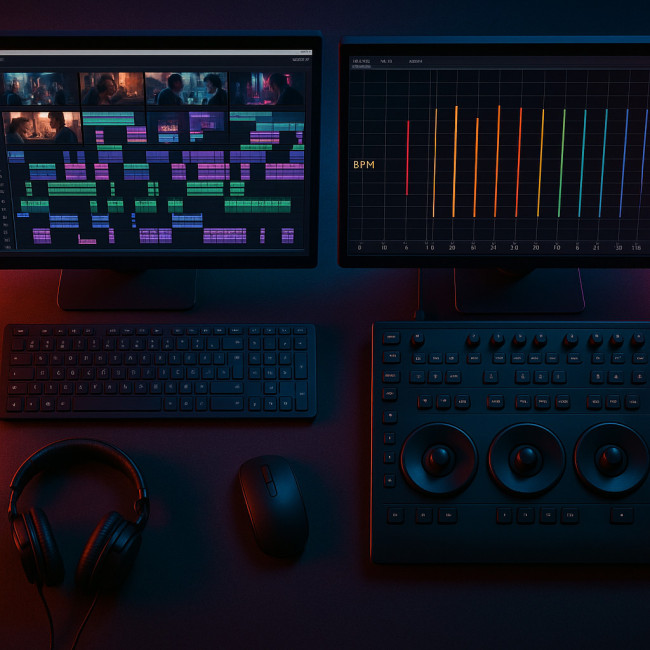Synced cuts and bpm: brief templates that align artists with music-video crews
Tired of videos that feel off-beat or edits that need endless revisions? A well-structured brief that ties musical BPM (beats per minute) to the intended cut rhythm slashes post-production time and keeps every stakeholder—artist, label and crew—moving in perfect sync. This guide shows you how.
Why BPM-driven briefs matter in 2025
Music videos compete in a scroll-first world where seconds decide whether viewers stay or swipe. Aligning cut frequency with a song's BPM increases perceived “tightness” and boosts average watch time by up to 23 % according to multiple platform benchmarks. A BPM-anchored brief:
- Speeds decision-making for directors and editors.
- Reduces revisions because timing targets are clear.
- Improves storytelling by matching visual energy to musical energy.
The three-layer template: overview
Below is a snapshot of the core sections your brief should include. Feel free to copy, paste and adapt.
| Layer | Key Questions | Impact on Final Cut |
|---|---|---|
| 1. Musical Map | What is the song's BPM? Where are chorus drops, bridges and tempo shifts? | Defines pacing grid for editors and on-set shot list. |
| 2. Visual Hooks | Which beats trigger camera moves, lighting cues or VFX? | Ensures every creative department fires at the same moment. |
| 3. Deliverable Specs | How many cut-downs (15 s, 30 s, 60 s) are needed and at which BPM multiples? | Saves hours during export and avoids rushed re-timing later. |
Step-by-step: building your BPM-synced brief
1. Start with a precision BPM reading
Use a DAW or free online analyzer to nail the exact BPM. Round numbers mislead editors. If the track sits at 89.76 BPM, document it.
2. Mark musical milestones
Create a time-coded map of major sections. Example:
- 00:00–00:14 Intro (no vocals)
- 00:15–00:44 Verse 1
- 00:45–01:15 Chorus 1 (double-speed hi-hats, perceived 179 BPM)
Attach this chart as page one of the brief so the storyboard aligns instantly.
3. Define visual energy tiers
Not every beat deserves a cut. Categorise beats into A-beats (must-sync cuts), B-beats (camera movement) and C-beats (background lighting cues). Editors then know where to focus.
4. Translate BPM into cut frequency
A simple formula helps:
Cut interval (seconds) = 60 ÷ (BPM ÷ beat multiple)
For a track at 120 BPM with cuts every 2 beats: 60 ÷ (120 ÷ 2) = 1 s per cut.
5. Insert camera & lens guidelines
If you plan rapid 0.5 s cuts, communicate that wider lenses or locked-off shots may be needed to avoid motion sickness.
6. Flag format-specific deliverables early
Short-form vertical assets (Reels, Shorts) often need different BPM multiples. Note these before the shoot so the crew captures coverage accordingly.
Template download (copy-paste)
Below is a condensed template. Replace items in brackets.
PROJECT: [Song Title] – [Artist Name]
BPM: [Exact BPM]
KEY MUSICAL MARKERS:
• 0:00–0:14 Intro – No cuts, slow slide-in text
• 0:15–0:44 Verse 1 – Cuts every 2 beats (1.2 s)
• 0:45–1:15 Chorus 1 – Rapid cuts every beat (0.6 s)
VISUAL HOOKS:
A-beat = Hard cut; B-beat = Camera pan; C-beat = Light flash
LENS & FRAMING NOTES: Close-ups limited to chorus to emphasise vocal hit.
DELIVERABLES:
• Main 4 K master
• 60 s edit (cuts every 2 beats)
• 30 s edit (cuts every beat, vertical)
• 15 s teaser (double-speed cut-downs)
Workflow tips to keep everyone in sync
- Kick-off call: Invite editor, DP and lighting designer. Walk through BPM map live.
- Share a pre-production questionnaire: Borrow prompts from the 15-question pre-production checklist to reveal hidden constraints early.
- Centralise assets: Use cloud folders named by time-code (e.g., “00_45-01_15_Chorus1”).
- Mid-shoot sync check: After the first setup, review a quick proxy edit to confirm timing.
- Label-ready packaging: Follow best practices in packaging music-video edits for multi-platform rollout so nothing derails during delivery.
Common pitfalls and how to dodge them
- Assuming every beat needs a cut: Over-cutting can exhaust viewers. Use contrast.
- Ignoring tempo changes: Many pop songs shift BPM subtly in bridges—flag them!
- Vague deliverable lists: Editors waste hours re-timing exports when specs arrive late.
- Lack of metrics: Provide goals (watch-time targets, share ratios) to keep the crew outcome-focused.
Beyond the brief: getting scouted for the next gig

When your video lands, update your directory presence quickly. Small metadata tweaks can boost gig bookings by 30 %, as covered in this optimisation guide. For labels evaluating new partners, the criteria detailed in label shortlisting metrics highlight the value of on-beat portfolios. A well-tagged reel ensures algorithmic matches surface your work to A&R scouts browsing creative directories late at night, giving you an edge over less meticulous competitors.
Ready to find crews already versed in BPM-synced editing? Browse the music-video videographer directory and filter by style, location and past chart hits.
Mini Quiz: Test your BPM-brief IQ
FAQ
- Do I need expensive software to calculate exact BPM?
- No. Free online BPM analyzers or your DAW's metronome view give precise readings.
- What if the artist wants a “loose” feel instead of strict cuts?
- Use BPM multiples (every 2 or 4 beats) or sync major transitions only, keeping the vibe relaxed.
- How early should I share the BPM map with crew?
- Share it during the first concept meeting—before storyboarding—so visuals evolve around timing.
- Can one brief cover multiple social formats?
- Yes. Include cut interval tables for each runtime (15 s, 30 s, 60 s) in the Deliverable Specs layer.
Key takeaways
- A precision BPM reading is the backbone of a solid brief.
- Three layers—Musical Map, Visual Hooks, Deliverable Specs—keep teams aligned.
- Cut interval formula: 60 ÷ (BPM ÷ beat multiple).
- Share the brief early, review mid-shoot and update directory profiles after release.
Activate your next project: copy the template above, book a BPM-savvy crew, and watch your video edits land perfectly on every beat.











